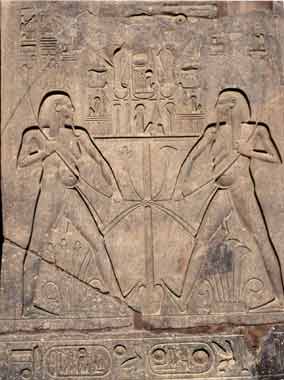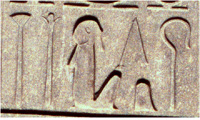|
Ancient
Egypt by Sjef Willockx |
||
|
Throughout ancient Egypt’s history, the Sma Tawy vignette was the most prominent platform for the Two Land’s heraldic plants. The earliest depictions of this vignette already date from the 1st dynasty. As far as the surviving evidence goes, it was then only employed on stone vessels. Ever since king Chefren of the 4th dynasty however, it regularly adorns the sides of the royal throne. Starting in the New Kingdom, it also appears on the side of the thrones of gods and goddesses.
The classic Middle and New Kingdom Sma Tawy consists of a bush of either plant, with one or two stalks of each tied around the hieroglyph smA: “to unite”. On either side stands one of the Two Kingdoms’ patron gods, or one of the Two Lands’ personifications, performing the act. Here is a typical New Kingdom example, from the throne of a colossal statue of Ramesses II (19th dynasty) at the temple of Luxor: (Click on the photograph to download a more detailed file). On the left (which also happens to be the south) stands the personification of Upper Egypt, recognizable by the lotus flowers on his head. On the right is his Lower Egyptian counterpart, with papyrus on his head. All flowers on the left are lotus, and all those on the right are papyrus. Since the flowers are in the middle tied together in a knot, it would have better suited our sense of composition if they would have changed position above the knot. But for the Egyptians, the demands of dogma were more important than those of composition. So all the flowers on the southern (Upper Egyptian) side are lotus, while all those on the northern (Lower Egyptian) side are papyrus.
The combined meaning is, that the gods Horus and Seth unite Lower and Upper Egypt under the rule of Sesostris. In the more ornate versions of the New Kingdom, the “tabletop” has widened considerably, to accommodate a more sizable chunk of titulature like in the example above from the Luxor temple. There we see in the middle the cartouche of Ramesses’ birth name: Ramesses, Beloved of Amun. It is flanked by two great uraei. To the left and right of these stands his Horus name: Strong Bull, Beloved of Maat. In the center, below the cartouche, stands a further epithet: Literally: "Ruler
of Lotus and Papyrus" During the Middle Kingdom, both versions of the Sma Tawy - those with the patron gods, and those with the personified lands - appear in equal frequency. From the New Kingdom on though, the version with the personified lands dominates. This is a bit disappointing, because the version with the patron gods makes such an eloquent and coherent statement: “Look: these gods unite the Two Lands under the rule of the king!” As the personified lands stand for the lands themselves, the alternative version lacks this grammatical purity.
|
|
|
|
|
All materials on this site are protected by copyright. All copyright by Sjef Willockx, unless otherwise indicated. |

